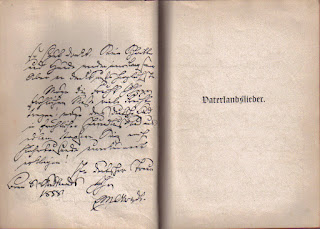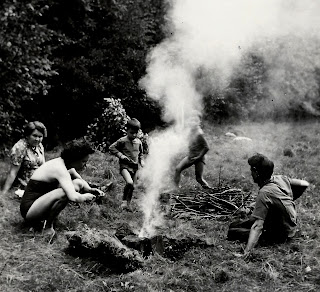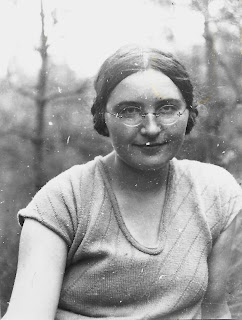One hundred years of cellotude continued:
Tenth and final part of
Chapter 1
A cello called Heinrich
Previous section: When the music stops
Herrenchiemsee, near Munich, 1950s. Heinrich Tiefenbach on the right, his wife must have taken the photo.
Silence after the war
On April 16, 1945, advancing US troops took over Wuppertal without a fight. Mayor Heinz Gebauer formally handed over the city in the town hall. On April 21, the Ruhr pocket capitulated and Wuppertal became part of the British occupied zone. The city had suffered widespread destruction. Of 140,000 homes, 55,000 were completely destroyed, only 50,000 remained unharmed. Max Heinrich and Maria were lucky in that their flat in the Gronaustraße remained intact.
On May 4, Max Heinrich filled in a questionnaire from the military administration about his activities during the Nazi era. On May 23 he was suspended from service in the city administration, effective at the end of the month. On the 26th, he was arrested by military police and interned at Camp Roosevelt at Hemer, in the Sauerland mountain region. Later he was moved back to be detained in the city’s own premises. Due to being classified initially as an “offender” he would not be able to return to work as a civil servant. Then again he was approaching pension age anyway.
In the meantime Maria got involved in black market as a travelling grandmother. As I understand it, this involved carrying goods on the pretence of taking them for your grandchildren. Which wasn’t too far from the truth as she actually had two grandchildren who were aged six and almost four when the war ended.
From 1946 to 1955 Max Heinrich worked as an accountant at the lawnmower manufacturer Brill in Wuppertal. I think that Robert Brill, born in 1893, whose birthday and address was noted in the pocket diaries, must have been the owner/boss of that company. Granddaughter Margarete recalled that the offices were provisionally housed on the corner Friedrich Engels Allee / Lohstraße and that Max Heinrich used to emphasize that after passing pension age he only worked there because Herr Brill was a close friend and he wanted to help him.
The company had a good run but was sadly swallowed by a competitor called AL-KO in 2009, which explains why I can’t find a company history online. Since its foundation in 1873, it had been independent for more than a century and the name still survives as a heritage brand. At the beginning of the 20th century the brothers Brill introduced the newfangled idea of mechanical lawnmowers to Germany – although they had been patented n Britain since 1830. A quote widely cited in German histories of lawnmowers reveals how the Brills presented the innovation to the general public at a trade far in 1904 claiming that they were already widely used in aristocratic and communal parks alike.
Meanwhile the reckoning with his tainted past continued. in October 1947 an initial examination based on the first questionnaire gave the result: „nicht tragbar“ which literally means not to be supported / carried which probably meant not allowed to stay in the civil service. In July 1948 his lawyer Dr Fechner filed an application for denazification submitting additional documents in December 1948.
Fechner pointed out that Max Heinrich had joined all those Nazi organisations only because of social pressure to do so and that his activities were restricted to the area of welfare. The lawyer claims that Max Heinrich had not realised the extent of the persecution of Jews and the establishment of concentration camps and vehemently objected to these crimes as and when he became aware of them. However, as the lawyer notes bluntly, with his family in mind he was lacking the courage to resign from the party and his functions.
In May 1946 a Jewish woman gave a witness statement in his favour saying that in the years 1940-1942 he had graciously and generously helped her with tax and private matters. “Mr Gross helped me even though he knew that I was Jewish” the witness confirmed.
Sadly the Jewish quartet player does not get mentioned in this document. We don’t know if he survived the Holocaust.
In January 1949 the verdict came in: Category IV, followers. This came with political sanctions and restrictions of movement, with the requirement to regularly report to the local police station,, but no restrictions on work, and no further detention. Denazification may have also been required for his pension to be paid out. Delays with that may have been behind his starting to work for Brill, although he certainly stayed there longer than would have been necessary.
The local denazification committee checked a total of 35,000 citizens of Wuppertal, with 95% being categorised as either followers or exonerated.
In the 1950s, life gradually normalised. Max Heinrich’s son Richard, thanks to his uncanny success in keeping a low profile throughout the Nazi times rapidly rose in the teaching hierarchy and became headteacher of a high school at Idar-Oberstein from 1950.
In the summer holidays of 1951 and 1954, Max Heinrich and Maria hosted Richard’s son Jörg. In 1953 and 1955 they travelled to Idar-Oberstein to attend the Confirmation ceremonies of their grandchildren.
They also went on holiday with the Tiefenbachs, a married couple who were close friends and had a VW Beetle. In July 1954, Max Heinrich and Maria had passports issued, which reveal that they travelled to Austria three times, in September 1954, 55 and 56. On the first trip, even the travel currency exchange had to be documented in the passport. In their photo album we find pictures of Kriml and Niederalpel (Steiermark) and Klein-Walsertal.
At other times they also enjoyed trips to mountainous regions in Germany. Holiday snaps taken by one of the quartet tend to show the other three in places like Hinterzarten, Tiefenbach (Allgäu), Königssee, Berchtesgaden, and Herrenchiemsee. There is a photo from Titisee in the Black Forest which exceptionally shows all four of them, posing with somebody dressed up as a polar bear. There was a traditional inn named “The Bear” at Titisee at the time, which apparently took pride in the animal connection and boasted bears in decorations and furniture. My best guess is that the travellers stayed there and that the group photo with bear was part of the service,
Heinrich Tiefenbach, born 1899, was among the 53 friends and acquaintances whose birthdays Max Heinrich had meticulously written down in the 1943 pocket diary. According to this source, Tiefenbach’s address was in the Gewerbeschulstr., which today boasts 25 companies, but there is none named Tiefenbach.
In the 1950s, the Tiefenbachs were neighbours, living diagonally opposite in the Gronaustr. Both couples met on Saturday nights to play cards and/or watch television at the Tiefenbachs’ flat. Looks like Max Heinrich found another quartet. The Tiefenbachs even joined them and provided Beetle transport for the family visits to Idar-Oberstein.
En route from Wuppertal to Idar Oberstein, Easter 1952.I'm assuming this was the car the friends had before the famous 1950s beetle, looks more like a pre-war model.
When the grandchildren came to visit them at Wuppertal, Maria was in charge of entertaining them. Both recalled cinema visits, which weren’t on offer back home. At the gigantic Thalia theatre in Elberfeld. In his brief memoir, Jörg specifically highlights the summer holidays of 1951, just before he moved to high school, and 1955, when the world championships of motor-paced bicycle racing (Steher-Rennen) took place in Wuppertal.
Max Heinrich, on the other hand, stayed home, the grandchildren reported. I wonder if he didn’t take part in the impressive cultural life of the aspiring metropolis at all. In February 1958, for instance, Herbert von Karajan and the Berlin Philharmonics played in the Stadthalle, a venue which is often praised for its excellent acoustics.
And in June 1955, the local Instrumental-Verein played Dvorak’s famous cello concerto with Paul Tortelier as the soloist. Which is significant because among the several LPs with this concerto I inherited from Richard there is one also starring Tortelier, first released 1950, so this could have been a purchase inspired by that concert. Even though he didn’t own a turntable, Max Heinrich could conceivably bought it for his son. We will never know.
While Maria entertained the grandchildren, Max Heinrich played patience (card solitaire) and smoked numerous cigars. The children counted up to 30 a day. He may have started smoking in the army during the first war, not sure. We do know from the second world war that Richard, who never smoked, transferred the tobacco rations he received as a soldier. After the war, relatives used to give him a special 5-mark cigar as a present on special occasions if they couldn’t think of anything else. As his health began to show the strain, his doctor tried to persuade him to give up. He declared, however: “If he insists, I’ll find a doctor who also smokes.” He only stopped smoking three days before he died.
In February 1958, his sister Gertrud died at the age of 77 years. On July 22 of the same year, Max Heinrich died aged 75. His golden wedding anniversary would have been on October 8 the same year. As mentioned above, the funeral featured a cellist playing Ave Maria (Schubert’s version I assume).
In August, Jörg came to visit Maria, created the photo album from the photos kept in two shoe boxes, and undertook a day trip to the World Exposition at Brussels with Maria.
In October 1960, after both children had started at university, Richard and Ruth moved to the house that they had inherited from Ruth’s aunt Johanna a few years earlier, which is in Hahnenbach, some 30 km from Idar-Oberstein. Richard now had to buy a car for the daily commute to his school.
In April 1961, Maria celebrated her 80th birthday at Hahnenbach and expressed the wish to stay there, but kept the flat in Wuppertal for the time being. In the summer, she had surgery for a hernia at the local hospital of Kirn. In October, during a visit to her old flat in Wuppertal with her sister Anna, she died suddenly, presumably of a heart attack.
Furniture and many personal items and documents from the flat were moved to Hahnenbach without much thought, which is why some rather unexpected things have survived to this day. Max Heinrich’s cello ended up in the attic of the Hahnenbach house for the next 20 years, again being stored under conditions that weren’t exactly
optimal for a venerable old cello.
As far as I know, music didn’t happen in either household after the string quartet stopped playing. My aunt on the maternal side recalled she was shocked to find out that her brother-in-law's family didn’t even sing Christmas carols.
At least one attempt was made, however. As I only found out in the course of this project, Richard organised private recorder lessons for his daughter. Her teacher was the husband of one of the teachers at his school. Margarete recalled that Richard also taught her some of the fundamentals and played a few notes himself to demonstrate things.
This father-daughter activity appears to have been immensely unpopular with the other half of the family, however. Margarete had to practice in the basement, and Jörg retained a life-long aversion to recorder sounds. On the occasion of his 80th birthday, also celebrated at Hahnenbach, he very nearly suffered an allergic shock when I unpacked a new alto recorder and gave it to my daughter to try.
With the dramatic spread of radio and record players in the mid 20th century, much of the motivation for amateur music making had of course disappeared. As mentioned, Richard had LPs with classical music and also recorded some on cassette tapes from radio programmes.
Note, however, that Maria’s nieces in Bruchsal raised a whole generation of professional musicians. Among the four grandchildren of Maria’s half-sister Anna we find a cellist, a gambist and a bass trombonist. Only one went against the grain and became a chef. Just how this clustering of musicians arose remains to be explained by science.
The silence in the household of my grandparents may have to do with the genes of my grandmother Ruth, who used to speak of her musical in-laws as a curiosity, to swiftly add that one of her relatives was so amusical that he was barred from becoming a teacher.
Specifically, the person in question was her great uncle Friedrich Kauer, born 1849 in Simmern, a younger brother of our Alsatian station master Christoph Gottlieb Kauer. He was really keen to become a teacher, but that would have required the ability to sing with the schoolchildren, which he couldn’t do. Therefore, he specialised in the newly emerging field of educating deaf children. He ended up being the head teacher of the Wilhelm-Augusta-Stift at Wriezen on the river Oder, one of the first special schools for the deaf. Although the building survives and today serves as the town hall of Wriezen, I have been unable to find any records of his activity there. This may be to do with the fact that the Nazis very swiftly disbanded this institution in 1934 and probably didn’t bother with archiving its records.
However, Ruth’s Kauer ancestry also includes quite a few other teachers and vicars, all of whom must have been able to sing, Precisely who did and who didn’t sing carols for
Christmas remains to be explored.


























































